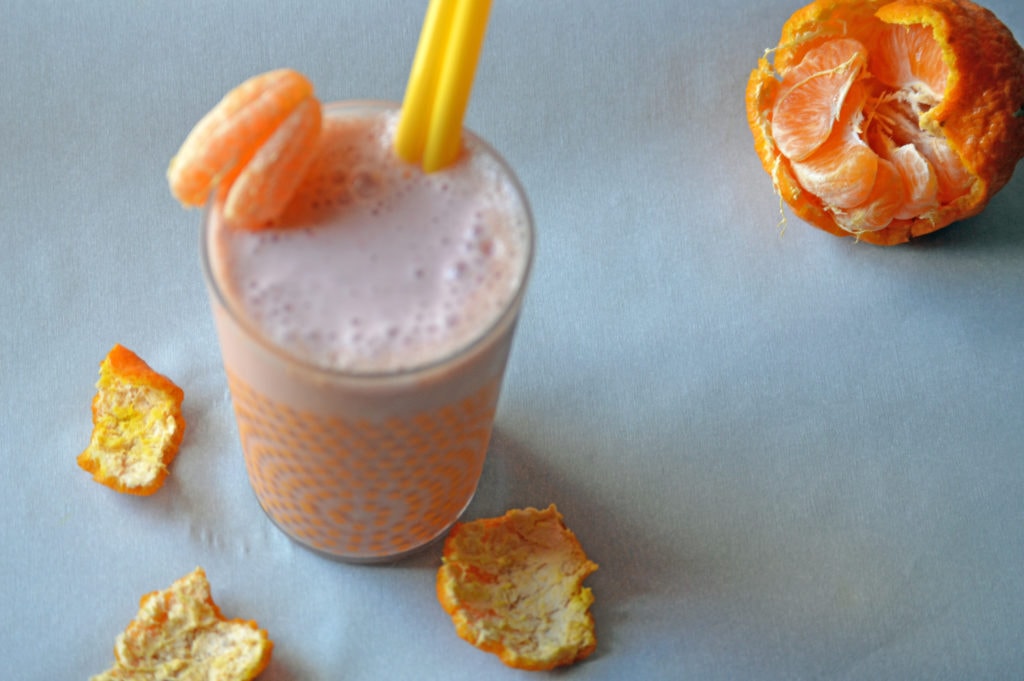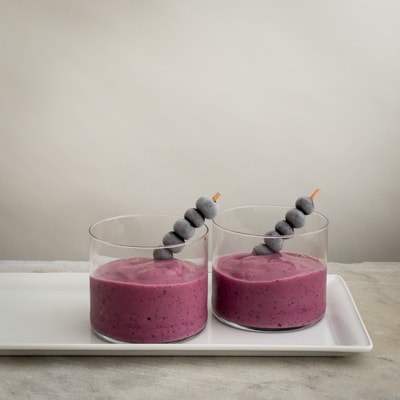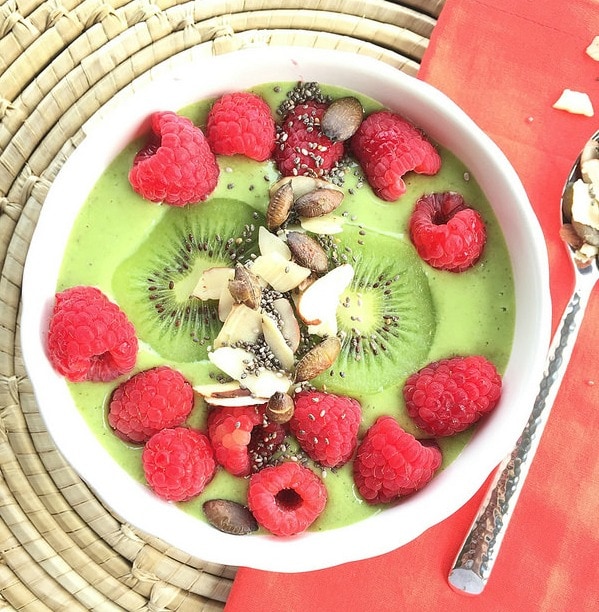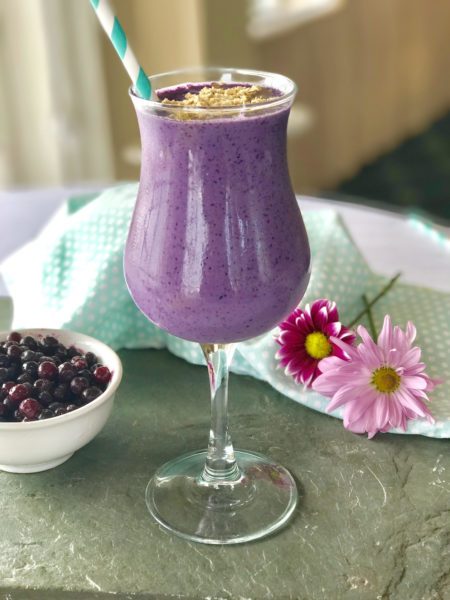Get 20 of the BEST healthy fruit & vegetable smoothie recipes, created by Nutritionists. Learn how to make a healthy smoothie with plenty of protein and find out what ingredients you should avoid!
Smoothies can be an incredibly easy way to get plenty of nutrients in your diet. Throw a bunch of fruits, veggies, and protein into a blender and enjoy sipping on a tasty and portable drink.
But making a healthy fruit and veggie smoothie can be a challenge. Without a good smoothie recipe, it’s hard to know what ingredients to use to get the right consistency and flavor. And it’s really easy (and tempting) to add sweeteners and other ingredients that make your smoothie a calorie and sugar bomb.

Making a healthy and delicious smoothie shouldn’t be complicated! These smoothie recipes, created by Registered Dietitians, are a great place to start if you’re looking for smoothie inspiration.
What are the best ingredients for smoothies?
The possibilities are endless when it comes to mixing and matching ingredients for a smoothie. Generally, I like to start with a base of a fruit or vegetable and add liquid (dairy milk or a plant-based milk alternative) and protein (greek yogurt, silken tofu, protein powder or plant-based yogurt).
For a more amped up smoothie, you can also include plant-based fat (nuts, seeds or nut butter), sweetener (maple syrup or honey) and whole-grain (rolled oats). You can add ice in too, but that’s totally optional.
Can a smoothie be unhealthy?
How could anything be wrong with packing all the nutrients and minerals you need into one drink? Unfortunately, there can be a downside to smoothies. Adding too many ingredients can make a smoothie really high in calories or sugar in some instances.
For example, adding a large serving of healthy fat ingredients like nut butters or seeds can drastically increase the calories. And having a heavy hand with sweeteners like maple syrup or honey may lead to going overboard on added sugars. That’s why it’s important to think about the right mix of ingredients in your smoothie.
Luckily, all of the recipes in this post are well balanced and take the guesswork out of making a smoothie. Follow one of these RD-approved recipes to get all the nutrients you need in one glass.
Can you use frozen fruit for smoothies?
I personally love to use frozen fruit in my smoothies! Not only does it make your smoothies colder for those scorching summer days, but you get an irresistibly creamy and thick texture. Think milkshake consistency but a healthier version… who would say no to that?
On top of that, frozen fruit is cheaper! And it has the same nutritional quality as fresh fruit. Fruit is usually frozen at the peak of its freshness, so it has all the nutrients and great taste locked in even when it’s not in season.
Not to mention that you can freeze fresh fruit that is about to go bad and preserve it for smoothie making. Maybe you didn’t get to those berries in the fridge and they are starting to look mushy. Wash them, throw them in a plastic bag and freeze them until you’re ready to make a smoothie!
Can you add fiber to a smoothie?
Believe it or not, this is one of the easiest nutrients to add to a smoothie. Most smoothies are usually already loaded with fiber from the fruit or vegetables. Unlike juicing, smoothies contain all of the fruit or veggie, including the skin and pulp. That means they have fiber locked in.
But to up your fiber came, include some of these other ingredients:
Fiber Sources:
- Flaxseeds
- Oats
- Hemp seeds
- Leafy greens
- Berries
- Chia seeds
Many of these ingredients double as both a source of protein and fiber. That means that less is more in this case. It’s not necessary to add every ingredient to hit your protein and fiber goals. A small amount of these ingredients should do the trick!
Healthy smoothie ingredients list
If you’re at a loss for what to put into your smoothie, look to these simple ingredients for inspiration.
1.Fruits
Any type of fruit adds natural sweetness to a smoothie without any added sugar. Fruit also boosts the vitamin, mineral, antioxidant and fiber content of your smoothie.
Pro tip– frozen fruit is more affordable than fresh. Plus, it’s frozen at the peak of freshness, so it tastes great, even when it’s not in season. The fruit possibilities are endless, but here are some of my favorites for smoothie making:
- Berries
- Mango
- Pineapple
- Melons
- Bananas
- Cherries
- Peaches
- Papaya
- Apples
- Citrus
- Pear
- Dates
- Avocado
2. Vegetables
Smoothies are a great vessel for adding veggies to your diet. Not only do veggies have plenty of fiber for very little calories, they also offer other important nutrients, like iron, folate, calcium, potassium, magnesium, antioxidants and tons of vitamins.
Not all veggies taste great in smoothies, but these do:
- Spinach
- Kale
- Cucumbers
- Zucchini
- Celery
- Squash (pumpkin, butternut)
- Pumpkin
3. Protein
Protein isn’t necessarily a food, but it’s a vital part of a smoothie because it helps keep you full. Plus, protein is necessary after a muscle recovery to help with muscle recovery.
Protein comes in many forms. Here are some of my favorites for smoothies:
- Milk (dairy or soy)
- Greek yogurt
- Cottage Cheese
- Silken tofu
- Protein powder
- Bee pollen (a little crunchy/ grainy if not blended all the way through)
- Nut butter
- Seeds, like flax and chia seeds
What to avoid
Certain ingredients can make your smoothie go from healthy beverage to decadent milkshake rather quickly. For example, the fruit juices and sweeteners, like honey, maple syrup, and agave, as well as flavored yogurts add unnecessary sugar and calories to a smoothie.
For example an 8 ounce plain greek yogurt has about 4 grams of natural sugar (from the lactose), as compared to 13 grams of sugar in a strawberry greek yogurt of the same brand.
In addition, be cautious about the amount of high calorie ingredients you add to a smoothie. While unsaturated fat sources help control hunger and keep you full, they also have more calories per gram than protein and fat.
Aim to add one type of fat to each smoothie, whether it’s nuts, nut butter, seeds or avocados. More than one can turn your smoothie into something that has more calories than a meal.
Below are some of the best smoothies from Dietitians. Hopefully these recipes will inspire you to pick up your blender and take a trip to the store or farmers market.
1. Tangerine Strawberry Creamsicle Smoothie by Greenletes

This smoothie will remind you of your childhood, ending warm summer days with an orange creamsicle from the ice cream truck. Instead of tons of added sugar, this mixture delivers the sweet taste of nostalgia with some protein that is perfect for a post-workout treat.
2. Sunshine Smoothie by Greenletes
Take a mental trip to the tropics. Sip on the refreshing combination of mango, banana, coconut, and clementines without any added sugar.
3. Mama’s Berry Smoothie by Toby Amidor

This classic smoothie combination provides inflammation-fighting antioxidants with a vegetarian-friendly protein punch from nonfat Greek yogurt.
4. Gorgeous Green Smoothie Bowl by Liz’s Healthy Table

Instead of drinking your smoothie from a glass, try scooping it up from your bowl. This smoothie bowl delivers nutrients and flavors with a variety of delicious toppings!
5. Vegan Berry Smoothie by Off the Vine Nutrition
For all my vegans out there, this smoothie is for you. This smoothie contains beets, a superfood veggie that has tons of antioxidant, fiber, folate and Vitamin C. Plus, it has protein from silken tofu, which adds a creamy richness to the smoothie.
6. Tropical Creamsicle Post Workout Smoothie by Bucketlist Tummy
Doesn’t the name of this smoothie make you want to eat it? Pick up a batch of cara cara oranges to make this delicious Vitamin C packed smoothie.
7. Green Smoothie by Desi Licious RD
What makes this smoothie green? Not kale…not spinach, but wheatgrass. Wheatgrass can have a bitter taste, but that is masked by the addition of naturally sweet pineapple. If you haven’t tried wheatgrass, it is high in Vitamin A, C, and E as well as some minerals.
8. Peanut Butter Banana Smoothie by Kroll’s Korner
Powdered peanut butter offers the flavor and protein of peanut butter without all the calories. For anyone watching their weight, this smoothie is a must try. It’s a delicious combination of peanut butter powder and bananas, and it will satisfy your sweet tooth.
9. Berry Dragon Fruit Smoothie by Grateful Grazer
The gorgeous smoothie gets its colorful hue from pink dragon fruit. The berries and the dragon fruit provide tons of flavor and ample antioxidants.
10. Pumpkin Smoothie Two Way by Triad to Wellness
Pumpkin isn’t only great for lattes and pies but can be a delicious base to a smoothie. This smoothie gives you the warm seasonal spices of the fall, while also providing fruits, veggies, protein and whole grains all in one glass.
11. Wild Blueberry Peanutty Protein Smoothie by Nutrition Starring You

This is another tasty smoothie with tofu. Although tofu may not be the first ingredient that comes to mind for a smoothie, it has a neutral taste that adds a lot of plant-based protein. This recipe also highlights delicious wild blueberries, which are loaded with inflammation fighting antioxidants.
12. Triple Berry Oat Smoothie with Hemp Seeds by Marisa Moore
If you’re not an oatmeal fan, you can add this nutritious whole grain to your smoothie. Oats contain a type of fiber called beta-glucan, which has been shown to lower cholesterol levels.
13. Cantaloupe, Ginger and Lime Smoothie by Make Healthy Easy
Cantaloupe may not be the first fruit on your mind, but it provides Vitamin A and C, as well as beta-carotene. This smoothie also has a unique taste with ginger and lime. And ginger helps aid in digestion.
14. Healthy Coffee Smoothie with Banana by Amy Gorin
Start your morning with an extra jolt of caffeine. This smoothie tastes like a Frappuccino, but will leave you feeling satiated, due to the protein and healthy fats from greek yogurt and peanut butter, respectively.
15. Pumpkin Pie Smoothie Bowl by Kara Lydon
This smoothie brings the flavors of a Thanksgiving dessert classic into a nutrient-dense smoothie bowl. Buy a can of pumpkin puree to enjoy the taste of fall all year round.
16. Peaches and Cream Smoothie Smoothie by Edwina Clark
In the summer peaches can be found in their peak season. Don’t want to wait until summer? Pick up some frozen peaches– they are flash frozen when they are at the peak of freshness, so they taste great all year round.
17. Turmeric, Mango and Carrot Smoothie by Sharon Palmer
The ingredients in this smoothie deliver vibrant golden hues that will make you think of a tropical sunrise. Turmeric, a spice, gives the smoothie the golden. Curcumin, the active property in turmeric, is high in antioxidants and provides many anti-inflammatory properties.
18. Peach Mango Smoothie by Hungry Hobby
Don’t be fooled by the green color of this smoothie. Although it has some spinach, it tastes like peach and mango. This is a great way to drink your greens and enjoy it!
19. Strawberry Kefir Smoothie by Jessica Levinson
This smoothie in unique in that it contains kefir, a fermented milk product, similar in consistency to drinking yogurt. Since kefir is fermented, it contains good-for-your-gut probiotics, as well as protein and calcium.
20. Tropical Smoothie Bowl by Jessica Spiro
This smoothie highlights fruits of the tropics; it is full of vitamins A and C, as well as provides omega-3 fats and protein. Be as creative with the toppings as you like!


0 Comments